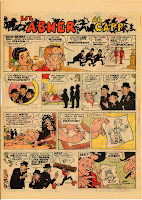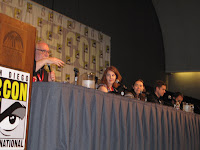 |
| Capp Self-Portrait, mid 1940's |
|
In October of 1968, the American cartoonist Alfred G. Caplin, better known as Al Capp (1909-1979), brutally parodied Charles Schulz's (1922–2000)
Peanuts over 3 consecutive Sundays in his own
Li'l Abner strip. Capp, perhaps the best-known satirist of his era, loved to parody fellow cartoonists. Milton Caniff enjoyed it when he and his characters were roasted, as did Allan Saunders (
Mary Worth). But Ham Fisher (
Joe Palooka) was an uncomfortable target. It was inevitable that
Peanuts was subject to Capp’s lampooning. Denis Kitchen & I, while researching another project, started thinking about the interactions between these two superstar cartoonists, who were total opposites in style and personality.

Al Capp, the older of the two, was the traditionalist.
Li’l Abner, the title he was best known for, debuted in 1934. His influences were the American comic strip cartoonists Tad Dorgan, Cliff Sterrett, Rube Goldberg, Rudolph Dirks, Fred Opper, Billy DeBeck, George McManus and Milt Gross and the
Punch cartoonist–illustrator Phil May. He was also well read, and devoured most of the literary classics while still a teenager. Once Abner was established, he kept a traditional shop, with many assistants working on the strip. At its height, Abner was a masterpiece of cultural and political satire. Capp was a larger than life personality that enjoyed fame and seemed to have a psychological need to stay in the public eye.
At the end of the 1940’s and into the 50’s, Capp was at the height of his popularity. In 1947, he was awarded the Ruben by the National Cartoonist Society, the subject of a long 2-issue profile in
The New Yorker and featured on the cover of
Newsweek. In 1948 the Shmoo craze erupted, with the orgy of merchandising that followed. In 1950, he was also cover profiled in
Time. In 1952, the wedding of Li’l Abner and Daisy Mae made national news, including the cover of
Life Magazine.
Building in momentum around this time, several social and cultural events happened that seemed to knock him off course:
- After the WWII era, there were physical changes in the format of comic strips themselves, forcing Capp to reduce the number of panels in his stories, and the amount of cross-hatching and detail customarily shown within the panels.
- There was the movement away from figurative work in the arts. Contrast the WPA social realist style of illustration, which would have been happening around the time Capp was beginning his career, with the Modernist movement of the Abstract Expressionists, such as the color-field paintings of Mark Rothko, or the minimalist paintings of Ellsworth Kelly and Frank Stella.
In the Li’l Abner strip Kissin’ Cousins, which ran on June 30, 1957, Capp spoofed modern art by having his character Tiny Yokum win a French art competition with a blank canvas. Tiny’s “prize-winner” references conceptual paintings like Kasimir Malevich’s White on White (1915) which hangs in the Museum of Modern Art (his related Black Square on White sold in 2000 for $1 million). American artist Robert Rauschenberg created his White Painting in 1951, comprising seven monochromatic white panels. Capp regarded such notorious works of “art” as intellectual fraud. His oft-quoted observation of abstract art was that it was "the product of the untalented, sold by the unprincipled to the utterly bewildered.”
- There was the generational change from the post-war and Eisenhower era into the social turmoil of the 1960’s. Capp was able to satirize political monsters like McCarthy, yet found the attitude of the 60’s generation unfathomable, even treasonous.
It is our feeling that Charles Schulz (1922-2000), whose
Peanuts strip was first syndicated in 1950 (and had a meteoric rise thereafter), may have indirectly become a living symbol of some of these changes for Capp. It was Schulz’s perception, mentioned in several interviews, that Capp was jealous of Schulz’s success, replacing him as the top cartoonist, and the bitter tone of Capp’s 1968 Peanuts parody seems to bear this out.
Schulz personally drew the
Peanuts strip himself, and liked the routine of it. He was an introspective man, who enjoyed approval, but was uncomfortable with being famous. Although he struggled with it in the beginning, Schulz settled into a very spare, modern, minimalist style of drawing. The interest in the collective unconscious, pop psychology, and the self-help fad (“stop smoking through self-hypnosis,” etc) that bloomed in 1950’s manifested in the militant self-empowerment of the 60’s, and the self-aware children of
Peanuts were ideally suited to the era.
Schulz was introduced to Al Capp sometime in the early 1950’s, in conjunction with the National Cartoonist Society (possibly by Mort Walker, who was president at that time). Schulz won the Ruben himself not long after, in 1955. It seems that in this period, a critical dialog developed between Schulz and Capp, arguably the two most visible American cartoonists. Schulz, for example criticized the marriage of the Abner characters as "the worst mistake Al Capp made" because it altered the fundamental dynamic of the strip. In 1965, Capp opined that the
Peanuts characters were "good, mean little bastards. Eager to hurt each other."
In the 60’s, Capp’s star was fading, and he took a few swipes at his “successor.” In his 1968 parody, he pointedly made fun of the psychological elements of
Peanuts, even going so far as to suggest that Schulz was one of those modern artists that didn’t know how to draw (“my kid could do that,” he implies through Abner’s sketch). “Well, it’s just about run its course, you know," Capp said at the time, "Little kids talking like adults. It’s just about run its course.” It seems ironic that Capp began his attack with comments about licensing and corporate sponsorship, considering the prodigious amount of merchandising and endorsements Capp had himself (although that time had largely passed for
Li’l Abner by the late ‘60s). Apparently the two artists had a falling out over these strips, but by 1995, in an interview with Gary Groth, Schulz characterized it as "an unfortunate misunderstanding."
In 1974 Capp attempted to cash in on the pop art craze by selling limited edition serigraph prints, apparently figuring that if people would pay Warhol and Lichtenstein millions for “rip-offs” of comics characters, they would jump at the chance to buy the “real thing,” ignoring the theoretical underpinnings of this kind of work. The general public snapped them up, but he did not win the critical acclaim he was reaching for. At this point,
Peanuts has become a worldwide phenomenon, and Capp, beset by personal scandal, is spiraling toward the end of his life and career.
Summary
Al Capp and Charles Schulz, who dominated the world of comic strips in their respective overlapping eras, are a study in remarkable contrasts. Each experienced a quick meteoric rise to fame from humble beginnings, Capp during the Great Depression and Schulz in the postwar boom, but their cartooning styles are virtual mirror opposites: Capp’s brushwork is dark, spotted heavily with black ink and cross-hatched. Even his lettering is bold. Schulz’s pen lines are light and spare but heavy with expression. Capp, a social creature, worked on his strip with several assistants; Schulz labored solo. Capp’s Dogpatch, almost devoid of children, was populated with scheming and power-hungry men, and with women who were either grotesque or voluptuous. Schulz’s asexual cartoon universe was virtually devoid of adults, yet its characters were often wise and world weary. Capp was a brash, outspoken East Coast Jew who craved the limelight and success, while Schulz was an introspective Midwesterner not especially comfortable with the limelight. Commercial success and television and Broadway adaptations aside, what they had in common was that each, in his own distinct way, captured the imagination and loyalty of tens of millions of readers daily while providing insights —both profound and funny— into the human condition.
Kim Munson & Denis Kitchen. Images © Capp Enterprises, Inc.



























